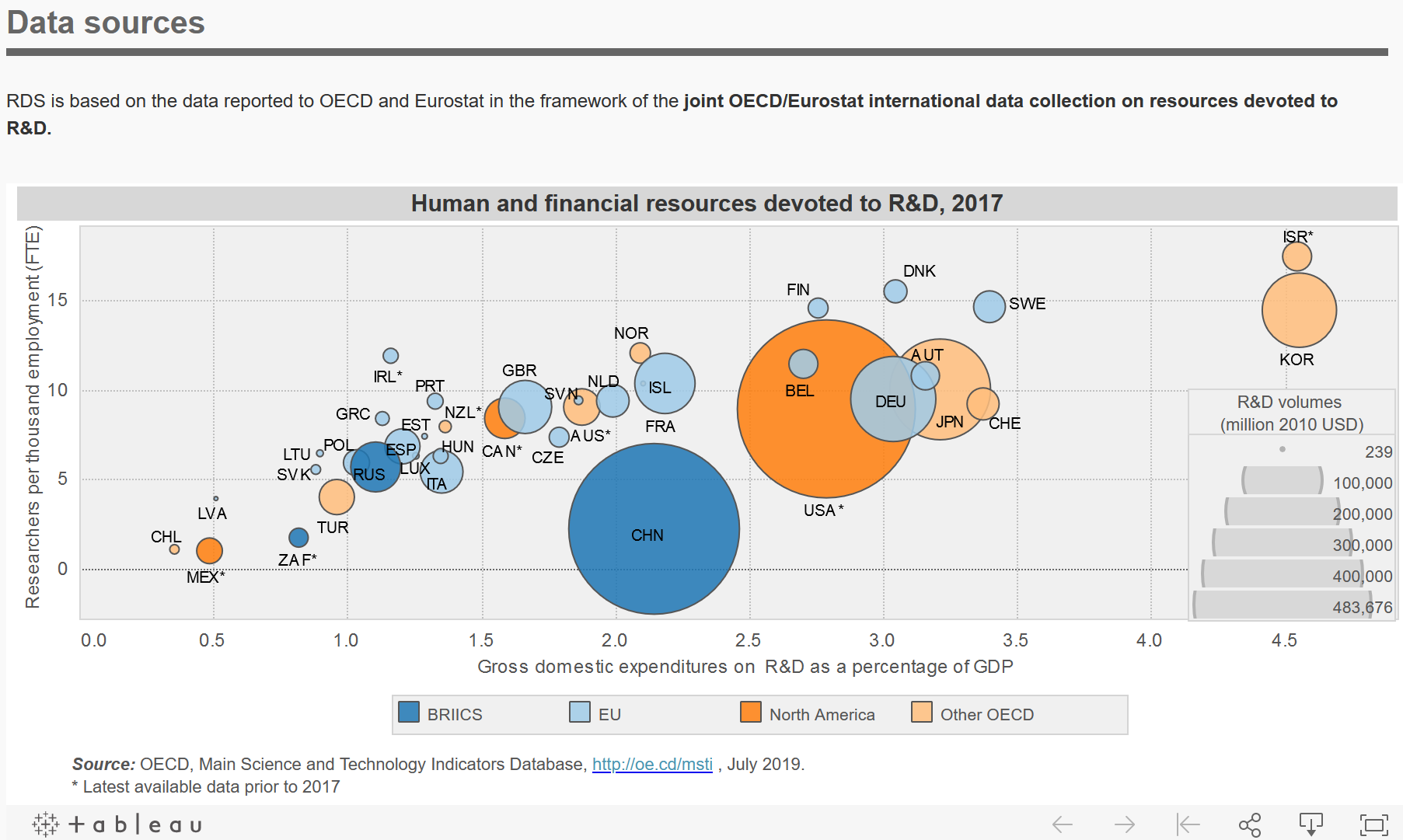博文
Research and Development Statistics (RDS)
||
Research and Development Statistics (RDS)
来源:http://www.oecd.org/sti/inno/researchanddevelopmentstatistic

Dataset coverage
The statistical series published start from 1981 and cover the following:
A first set of tables deals with gross domestic expenditure on research and experimental development (GERD).
This covers all R&D carried out on a national territory in the year
concerned using various breakdowns. R&D expenditure data are
expressed in million national currency, million current PPP$, and
million constant $ (2010 prices and PPPs).
Gross domestic expenditure on R&D by sector of performance and source of funds
Gross domestic expenditure on R&D by sector of performance and type of expenditure
Gross domestic expenditure on R&D expenditure by sector of performance and type of R&D
Gross domestic expenditure on R&D by sector of performance and field of R&D
Gross domestic expenditure on R&D by sector of performance and socio-economic objective
The second set covers resources devoted to R&D measured in labour terms, i.e. R&D personnel
by sector of employment and various breakdowns. R&D personnel data
are expressed in full time equivalents on R&D (FTE) and in
headcounts.
Datasets on R&D expenditure and personnel are also provided for R&D carried out in the business enterprise sector with detailed data by industry or size class. Additionally R&D in the higher education and private non-profit sectors are also available with detailed data by field of research and development or type of costs.
Business enterprise R&D expenditure by main activity (focussed) and source of funds
Business enterprise R&D expenditure by main activity (focussed) and type of expenditure
Business enterprise R&D expenditure by source and funds and number of person employed
R&D personnel in the business entreprise sector by main activity
Government Budgets on R&D
The R&D expenditure and personnel tables are based on surveys of the units carrying out the R&D and national estimates and provisional data have been included when available. More up to date information on government intentions or objectives when committing money to R&D can be derived from budgets. These data are shown in the Government budget allocations for R&D (GBARD) table, which includes the breakdown of government R&D budgets by socio economic objective (SEO).
Historical R&D Expenditure Series
In addition to these tables updated once a year, a subset of (discontinued) historical series are also available.
Gross domestic expenditure on R-D by sector of performance and source of funds (1963-1980)
R-D expenditure by sector of performance and type of R-D (1963-1980)
R-D personnel by sector of employment and occupation (1963-1980)
These tables contain recently digitised historical OECD research and development (R&D) expenditure and personnel statistics for the period 1963-1980. These represent data collected by OECD among member countries following the publication of the OECD Frascati Manual in 1963 and its two subsequent revisions in 1970 and 1974. Methodological notes by country and indicator are available in this publication. Because of the discontinuities in the data, these historical series are presented separately from the OECD Research and Development Statistics publication. Researchers and the public in general with an interest in this subject are invited to investigate the features of these historical data. Independent efforts to attempt to construct consistent series and derive long-term historical indicators are encouraged for research purposes, subject to appropriate attribution and description of sources.
To complement these historical series, a few dataset reflecting the former data collection based on the 2002 version of the Frascati Manual are also available.
Business entrerprise R&D expenditure by industry (ISIC rev. 3)
Business entrerpsie R&D expenditure by industry and source of funds (ISIC rev. 3)
Business entreprise R&D expenditure by industry and type of cost (ISIC rev. 3)
Other national R&D expenditure on R&D by field of science and source of funds
Other national R&D expenditure on R&D by field of science and type of costs
Quality control and international comparability
R&D data are collected at a national level through surveys and other sources following the recommendations of the OECD Frascati Manual, which is the internationally recognised standard in this area (http://www.oecd.org/sti/inno/frascati-manual.htm)
Data are then submitted by national contacts to the OECD (in co-ordination with Eurostat for EU countries) and reviewed in order to ensure consistency
Countries are also required to provide detailed metadata in order to identify and assess any deviations from the Frascati guidelines
When data are disseminated, flags are used to provide information on specific series and datapoints.
Related links and further reading
The RDS database is the main foundation for the Main Indicators of Science and Technology (MSTI) publication and accompanying database. MSTI, published twice yearly, provides a set of indicators on the level and structure of R&D efforts undertaken by the 42 economies covered by the RDS database. These cover the resources devoted to research and development, patent families, technology balance of payments and international trade by highly R&D-intensive industries.
The ANalytical Business Expenditure on Research and Development database (ANBERD) builds upon the RDS data on Business R&D Expenditures broken down by Main Activity and Industry Served, by using estimation methods to address data gaps and discontinuities to provide consistent, internationally comparable series on business sector R&D expenditures.
The OECD Science Technology and Industry Scoreboard, published every other year, features indicators traditionally used to monitor developments in science , technology, innovation and industry, and complements them with new and experimental indicators that provide new insights into areas of policy interest.
研究与发展统计(RDS)(Research and Development Statistics (RDS))
2019年版的研究与发展统计(RDS)提供了有关所有OECD国家和某些非成员经济体用于研发的资源的大量最新数据。
从1981年开始发布统计系列,涵盖以下内容:
第一组表处理研究和实验开发(GERD)的国内总支出。这涵盖了当年在国家领土上使用各种细目分类进行的所有研发。研发支出数据以百万本国货币,百万现价PPP $和百万不变价(2010年价格和PPPs)表示。
按绩效部门和资金来源分列的国内研发总支出
按绩效部门和支出类型分列的国内研发总支出
按绩效部门和研发类型分列的研发支出国内总支出
按绩效部门和研发领域分列的国内研发总支出
按绩效部门和社会经济目标分列的国内研发总支出
第二组包括按劳力衡量的用于研发的资源,即按就业部门和各种细分分类的研发人员。研发人员数据以等同于研发(FTE)和人数的全职时间表示。
按就业和职能部门划分的研发人员
按就业和资格部门划分的研发人员
按就业部门和研发领域分的研发人员
还提供了在企业部门进行的R&D支出和人员的数据集,并提供了按行业或规模分类的详细数据。此外,还可以根据研究和开发领域或成本类型提供高等教育和私人非营利部门的R&D以及详细数据。
商业企业按行业划分的研发支出
按主要活动(重点)和资金来源分的企业R&D支出
按主要活动(重点)和支出类型划分的企业R&D支出
按来源和资金以及从业人数划分的企业研发支出
商业活动领域的研发人员主要活动
政府研发预算
研发支出和人员表是基于对进行研发的单位的调查得出的,国家估计数和临时数据已包括在内。可以从预算中获得有关在研发方面投入资金的政府意图或目标的最新信息。这些数据显示在政府研发预算拨款(GBARD)表中,其中包括按社会经济目标(SEO)划分的政府研发预算。
历史研发支出系列
除了这些表每年更新一次,还提供(已停产)历史系列的子集。
按绩效部门和资金来源分列的R-D国内总支出(1963-1980)
按绩效部门和R-D类型划分的R-D支出(1963-1980)
按就业和职业部门划分的研发人员(1963-1980)
这些表包含了1963年至1980年期间经合组织最近的数字化历史研发(R&D)支出和人员统计数据。这些代表的是经合发组织在1963年发布《经合组织弗拉斯卡蒂手册》及其1970年和1974年的两次修订本之后在成员国之间收集的数据。该出版物提供了按国家和指标划分的方法学注释。由于数据的不连续性,这些历史系列与OECD研究与发展统计出版物分开显示。欢迎对此主题感兴趣的研究人员和公众研究这些历史数据的特征。出于研究目的,鼓励进行独立的尝试以构建一致的序列并得出长期历史指标,但要有适当的来源和描述,但要出于研究目的。
为了补充这些历史系列,还提供了一些反映2002年版《弗拉斯卡蒂手册》的数据集的数据集。
按行业划分的企业企业研发支出(《国际标准产业分类》修订版3)
按行业和资金来源分列的商业企业研发支出(《国际标准产业分类》第三版)
按行业和成本类型划分的企业研发支出(ISIC修订版3)
按行业划分的企业企业研发人员(《国际标准产业分类》修订版3)
按科学领域和资金来源分列的其他国家研发支出
按科学领域和成本类型分列的其他国家研发支出
质量控制和国际可比性
遵循经合组织《弗拉斯卡蒂手册》的建议,通过调查和其他来源在国家层面收集研发数据,该手册是该领域的国际公认标准(http://www.oecd.org/sti/inno/frascati-manual. htm)
然后,国家联系人将数据提交给经合组织(与欧盟国家的欧盟统计局协调)并进行审查,以确保一致性
还要求各国提供详细的元数据,以便识别和评估。
https://wap.sciencenet.cn/blog-113146-1271980.html
上一篇:信息科学与图书馆学期刊(WoS)
下一篇:OECD Science, Technology and Innovation Outlook 2021